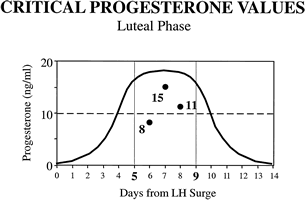Understanding Infertility
Progesterone (P4)
Bloodwork
Anti-Muelleran Hormone (AMH)
AMH is a protein that surrounds each egg in the body. A a woman is born with all the eggs she will have during her lifetime, AMH is a good indicator of egg supply. If a woman has a high number of eggs, her AMH will be higher; inversely, a low AMH indicates a lack of eggs. Additionally, an extremely high AMH can be an indicator of polycystic ovary syndrome (PCOS), lack of ovulation and irregular periods.[1]
The range for AMH is as follows:
High
>3.0 ng/mL
Normal
1.0-3.0 ng/mL
Low Normal
0.7-1.0 ng/mL
Low
.03-.07 ng/mL
Very Low
<.03 ng/mL
A woman’s AMH will drop as she gets older and has less eggs in her supply.[2]
AMH can also affect treat outcomes. High AMH will have a low stimulation treatment to avoid overstimulation. A low AMH will see the need for more stimulation to get the eggs to respond to treatment.[3]
Follicle-Stimulating Hormone (FSH)
FSH is a hormone secreted by the pituitary gland that stimulates estrogen (Estradiol / E2) and egg development. The ranges for FSH can vary by clinic, but a normal range is said to be between 4.7 – 21.5 mIU/mL (or 4.5-21.5 IU/L).[4]
High and low FSH levels can be indicators of more serious problems. Low FSH can lead to non-ovulation and irregular periods due to no egg development.
High FSH can show menopause or premature menopause is approaching. The body must produce a high amount of FSH to combat the declined or declining egg supply.[5]
Luteinizing Hormone (LH)
LH is also a hormone produced in the pituitary gland. While FSH stimulates the body to produce eggs, LH takes over to induce ovulation.
There are different levels of LH that should be seen during a complete cycle:
-
1.9 – 12.5 IU/L for the beginning of a cycle.
-
8.7 – 76.3 IU/L during peak fertility and ovulation.
-
0.5 – 16.9 IU/L after ovulation and before a new cycle.[6]
High levels of LH can indicate issues such as premature menopause or PCOS. Low levels of LH can indicated a lack of ovulation or pituitary gland disorders.
As FSH and LH work together to create healthy eggs and ovulate, the role of LH still remains acutely controversial. However, LH is still commonly tested and what is used in ovulation predictor kits (OPKs.)[7]
Estradiol (E2)
Estradiol (E2) is the body’s naturally made estrogen that is secreted by a woman’s ovaries. As the follicles grow, they release E2 into the body. The level of E2 in the blood can determine if eggs are being produced. Additionally, E2 levels can show if the FSH in the blood was accurate as E2 suppresses FSH.[8]
E2 levels can be anywhere from 10-300 pg/mL at different points in the cycle. Closer to ovulation, E2 should be higher due to egg production and maturation. If the level is too high at the beginning of the cycle, this can mean premature menopause or poor ovarian reserve. Likewise, low E2 can be lack of ovulation.[9]
E2 is especially important during medicated IVF cycle. Low E2 during IVF stimulation can mean that eggs are not being produced. High E2 means that overstimulation and ovarian hyperstimulation syndrome (OHSS) may become an issue.[10]
Progesterone (P4) is a hormone that is produced in the ovaries that helps prepare your womb for a fertilized egg to attach.
Normal levels are as follows:
-
Beginning of the period: <1 ng/mL
-
Middle of the period: 5-20 ng/mL
-
After ovulation: 78 ng/mL
Your doctor will check P4 on Day 21 of your cycle to see that ovulation occurred. A low P4 level suggests that ovulation did not occur and pregnancy is not possible that month.[11][12]
If your P4 is low, there are pills or shots available to increase it. There are usually used mainly during IUI or IVF as P4 will not be secreted naturally.
It is important to note that just one of these numbers alone will not give you an idea of your fertility. They must be used together in order to get a clear picture.
[1] Bill L. 2016. “What Is an Anti-Mullerian Hormone (AMH) Blood Test?” RMA of Philadelphia. 2016. https://rmaspecialists.com/what-is-an-anti-mullerian-hormone-amh-blood-test/.
[2] “Anti-Mullerian Hormone (AMH) Testing of Ovarian Reserve.” 2013. Reproductive Medicine Associates of New Jersey. 2013. https://www.rmanj.com/anti-mullerian-hormone-amh-testing-of-ovarian-reserve/.
[3] Knez, Jure, Borut Kovačič, Maruška Medved, and Veljko Vlaisavljević. 2015. “What Is the Value of Anti-Müllerian Hormone in Predicting the Response to Ovarian Stimulation with GnRH Agonist and Antagonist Protocols?” Reproductive Biology and Endocrinology : RB&E 13 (June). BioMed Central: 58. https://doi.org/10.1186/s12958-015-0049-5.
[4] “Follicle-Stimulating Hormone (FSH) Blood Test.” n.d. MedlinePlus Medical Encyclopedia. Accessed April 30, 2018. https://medlineplus.gov/ency/article/003710.htm.
[5] “How Do FSH Levels Affect Fertility?” n.d. Fairhaven Health. Accessed April 30, 2018. https://www.fairhavenhealth.com/fsh-levels-fertility.
[6] Ellia, Mary Allen, Nall, Rachel. 2017. “Luteinizing Hormone (LH) Blood Test: Procedure and Results.” Healthline. 2017. https://www.healthline.com/health/lh-blood-test.
[7] Kumar, Pratap, and Sameer Farouk Sait. 2011. “Luteinizing Hormone and Its Dilemma in Ovulation Induction.” Journal of Human Reproductive Sciences 4 (1). Wolters Kluwer -- Medknow Publications: 2–7. https://doi.org/10.4103/0974-1208.82351.
[8] “Estradiol Levels.” n.d. Fertility Authority. Accessed April 30, 2018. https://www.fertilityauthority.com/tests-and-medications/blood-tests-infertility/estradiol-levels.
[9] Delaney, Abigail, Jensen, Jani R., Morbeck, Dean. 2012. “Fertility Testing.” AACC. 2012. https://www.aacc.org/publications/cln/articles/2012/november/fertility-testing.
[10] Aboulghar, M. 2003. “Prediction of Ovarian Hyperstimulation Syndrome (OHSS): Estradiol Level Has an Important Role in the Prediction of OHSS.” Human Reproduction 18 (6). Oxford University Press: 1140–41. https://doi.org/10.1093/humrep/deg208.
[11] “Day 21 Testing: Fertility Tests for Women.” n.d. RMACT. Accessed April 30, 2018. https://www.rmact.com/getting-started/fertility-testing/day-21-testing.
[12] Holm, Gretchen. 2016. “Serum Progesterone Test: Purpose, Results, and Risks.” Healthline. 2016. https://www.healthline.com/health/serum-progesterone.




